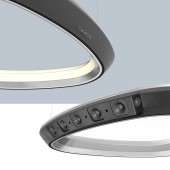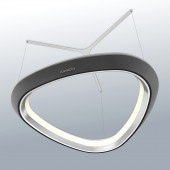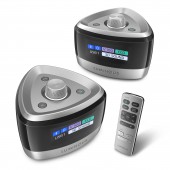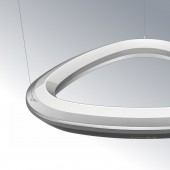
| THE AWARD |
| CATEGORIES |
| REGISTRATION |
| SUBMIT YOUR WORK |
| ENTRY INSTRUCTIONS |
| TERMS & CONDITIONS |
| PUBLICATIONS |
| DATES & FEES |
| METHODOLOGY |
| CONTACT |
| WINNERS |
| PRESS ROOM |
| GET INVOLVED |
| DESIGN PRIZE |
| DESIGN STORE |
| THE AWARD | JURY | CATEGORIES | REGISTRATION | PRESS | WINNERS | PUBLICATIONS | ENTRY INSTRUCTIONS |
Luminous Lighting and Sound System by Mohammad Hossein Namayandegi |
Home > Winners > Design #71963 >Interview |
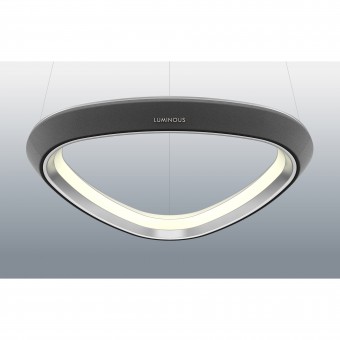 |
|
FS: What is the main principle, idea and inspiration behind your design?
MN: Luminous offers an ergonomic lighting and spherical surround sound system in a single product. It creates surround dome-shaped sound in the room without the need for wiring and installing multiple speakers around the place, and as a pendant light, Luminous has been designed to create indirect lighting. This lighting system provides a soft, uniform, and low-contrast light which prevents glare and vision problems. This product is inspired by nature. The indirect lighting system works in the same way as the sky in nature, the sky distributes light across a large surface and creates desirable ambient light. The sound system of the product also transmits the sound to the listener in the same way as it is in nature, in multilayer levels, and from all directions.
FS: What has been your main focus in designing this work? Especially what did you want to achieve?
MN: I was looking to design a product which makes a new experience for the users by creating an emotion that they desire to feel, including peace, excitation, or companionship with friends, in working or living spaces.
FS: What are your future plans for this award winning design?
MN: I am intended to find a company which can produce this product
FS: How long did it take you to design this particular concept?
MN: About 6 months
FS: Who is the target customer for his design?
MN: Luminous has a wide range of potential users. This is a multi-functional product which can be used in the home when listening to music, watching movies or using the game console, and furthermore, it can be utilized in conference rooms, educational environments, or shops.
FS: Which design tools did you use when you were working on this project?
MN: I used TRIZ method for idea generation and Rhinoceros for modeling almost 20 different concept
FS: What is the most unique aspect of your design?
MN: It creates both direct and indirect lighting. Moreover, while the wireless speakers in existing audio systems essentially require power and wiring, (only the emission of sound is done wirelessly), but "Luminous" simulates 3D sound without the need for installing multiple speakers around the place and provides a fully wireless audio system and this has a huge impact on the beauty of the environment.
FS: What is the role of technology in this particular design?
MN: Luminous uses LED light sources and equipped with an Ambient Light Sensor that adjusts the brightness of the LEDs on the basis of the ambient light level in the room. This function improves the efficiency of energy use, especially in rainy and cloudy days when the intensity of sunlight is constantly changing. The sound system consists of 20 small speakers that use a processor to emit the sound in the form of separate channels with different output intensity, in a 360-degree radius and at different firing angles. Consequently, it creates various real and virtual sound sources in the room by reflecting sound off of the floor and walls, bouncing it back into the listener's position, (combination of indirect and direct sound is created). In this case, the sound has vertical and horizontal dimensions and it means the height layer and ear-level layer of the sound are activated which simulate 3D sound.
FS: Is your design influenced by data or analytical research in any way? What kind of research did you conduct for making this design?
MN: My aim was to create a spatial sound system and natural and efficient lighting, so I did comprehensive research about generation and perception of sound and light in nature, Ergonomic guidelines for lighting design, applicable technologies and the design trend of the current samples.
FS: What are some of the challenges you faced during the design/realization of your concept?
MN: The most challenging issue during the design process was to make a balance between the product's form and functions. In fact, the core functions of the product had a dominant effect on its form. Moreover, the product should not look unusual, weird and bulky, but appealing, functional and compatible with different environments.
FS: How did you decide to submit your design to an international design competition?
MN: I thought this is the best way to publicize my work
FS: What did you learn or how did you improve yourself during the designing of this work?
MN: Working hard and not to be frustrated when you face some barriers. There is always a design solution which will work.
FS: Thank you for providing us with this opportunity to interview you.
A' Design Award and Competitions grants rights to press members and bloggers to use parts of this interview. This interview is provided as it is; DesignPRWire and A' Design Award and Competitions cannot be held responsible for the answers given by participating designers.
| SOCIAL |
| + Add to Likes / Favorites | Send to My Email | Comment | View Press-Release | Translations |
